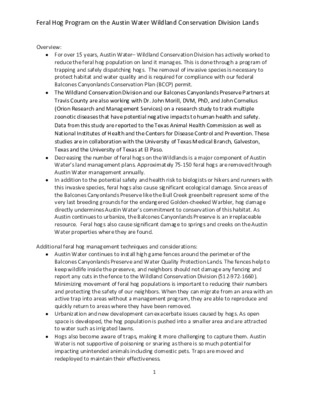4c Feral Hog Program Austin Water WCD — original pdf
Backup

Feral Hog Program on the Austin Water Wildland Conservation Division Lands Overview: • For over 15 years, Austin Water– Wildland Conservation Division has actively worked to reduce the feral hog population on land it manages. This is done through a program of trapping and safely dispatching hogs. The removal of invasive species is necessary to protect habitat and water quality and is required for compliance with our federal Balcones Canyonlands Conservation Plan (BCCP) permit. • The Wildland Conservation Division and our Balcones Canyonlands Preserve Partners at Travis County are also working with Dr. John Morill, DVM, PhD, and John Cornelius (Orion Research and Management Services) on a research study to track multiple zoonotic diseases that have potential negative impacts to human health and safety. Data from this study are reported to the Texas Animal Health Commission as well as National Institutes of Health and the Centers for Disease Control and Prevention. These studies are in collaboration with the University of Texas Medical Branch, Galveston, Texas and the University of Texas at El Paso. • Decreasing the number of feral hogs on the Wildlands is a major component of Austin • Water’s land management plans. Approximately 75-150 feral hogs are removed through Austin Water management annually. In addition to the potential safety and health risk to biologists or hikers and runners with this invasive species, feral hogs also cause significant ecological damage. Since areas of the Balcones Canyonlands Preserve like the Bull Creek greenbelt represent some of the very last breeding grounds for the endangered Golden-cheeked Warbler, hog damage directly undermines Austin Water’s commitment to conservation of this habitat. As Austin continues to urbanize, the Balcones Canyonlands Preserve is an irreplaceable resource. Feral hogs also cause significant damage to springs and creeks on the Austin Water properties where they are found. Additional feral hog management techniques and considerations: • Austin Water continues to install high game fences around the perimeter of the Balcones Canyonlands Preserve and Water Quality Protection Lands. The fences help to keep wildlife inside the preserve, and neighbors should not damage any fencing and report any cuts in the fence to the Wildland Conservation Division (512-972-1660). Minimizing movement of feral hog populations is important to reducing their numbers and protecting the safety of our neighbors. When they can migrate from an area with an active trap into areas without a management program, they are able to reproduce and quickly return to areas where they have been removed. • Urbanization and new development can exacerbate issues caused by hogs. As open space is developed, the hog population is pushed into a smaller area and are attracted to water such as irrigated lawns. • Hogs also become aware of traps, making it more challenging to capture them. Austin Water is not supportive of poisoning or snaring as there is so much potential for impacting unintended animals including domestic pets. Traps are moved and redeployed to maintain their effectiveness. 1 Feral Hog Program on the Austin Water Wildland Conservation Division Lands • Currently, WCD has 10 hog traps on the Water Quality Protection Lands and 6-8 active traps on the Balcones Canyonlands Preserve. Traps are cycled in and out of use so that they can remain effective as hog populations become aware and wary of them. • When deployed, traps have food, shade, and water and are equipped with a camera that can be viewed remotely by cell phone. The trap door can be operated remotely so that when a large group of hogs enters overnight, staff can shut the door. • After all necessary parties (biologists, volunteer coordinator, contractors, etc.) are notified and the division manager gives approval, qualified staff or contractor dispatches each hog. • Staff or contractors provide an all-clear call when dispatching is ceased. • The animals are then moved to a remote part of the property to decompose, making a • return to the environment. In the coming fiscal year, we have funds to purchase more remotely operated camera traps to increase our efforts. • Austin Water is unable to conduct trapping outside of the land it manages, but converses regularly with neighbors about this and other issues related to Austin’s wildland urban interface. The Wildland Conservation Division directs neighbors and other property owners to Texas Parks and Wildlife Department and the Texas A&M AgriLife Extension program for additional resources about feral hogs. • Texas Parks and Wildlife Department lists among frequently asked questions, “Can I wipe out a hog population through hunting or trapping?” that “The feral hog has managed to survive, adapt, and increase their numbers despite attempts at population control. While it is possible to keep the population in check with continuous control, it is highly unlikely to eradicate a hog population within an established range.” Resources for neighbors: • Members of the public can refer to the Texas Parks and Wildlife Department and the Agrilife Extension for best practices in deterring hogs from private property as well as removing them outside of the City. • https://feralhogs.tamu.edu/ • https://agrilifeextension.tamu.edu/solutions/feral-hogs/ • https://tpwd.texas.gov/huntwild/wild/nuisance/feral_hogs/ 2